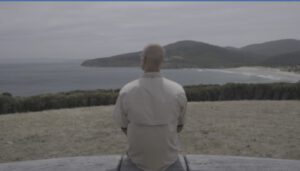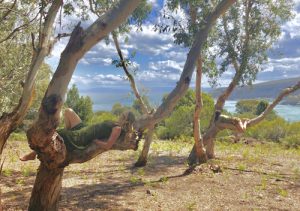Normally, life at Windgrove is a solitary affair far from the cutting edge of science and the action packed social venues of cities and universities.
This past week, however, a global team of paleoanthropologists camped out here for four days while they collected nine fossilized bones from an unknown species of a pre-human hominin that could revolutionize the Darwinian idea of evolution.
They have determined that fossilized hominin bones found in a cliff face nearby to Windgrove confounds the long established paradigm that the age of humans began relatively recently and solely in Africa.
Near the bottom of the photo is a grayish horizontal section of vertical grooves. This layer, approximately four to six meters tall and over 50 meters long is where the discovery has taken place.
What makes this area so astonishing is that it is sandwiched between two geologic layers of extremely ancient stone. The bottom layer is sedentary rock laid down in the Silurian Period 443-418 MYA (million years ago). The top layer is sandstone put down in the Triassic Period 250-299 MYA.
What this means, and the reason behind all the excitement, is that these fossilized hominin remains must have been deposited between 300 and 400 million years ago during the Devonian or Carboniferous Period.
To date, the earliest known fossil records of bipedalism are the Orrorin leg bones from Africa that are carbon dated to be only six million years old.
Plate tectonics at the time of the deposition of these bones would have this part of Tasmania (as part of the larger Gondwana super continent) drifting towards the equator; hence, temperatures were much higher with a prodigious amount of forested landscape (the darker areas to the right of the horizontal grayish section are coal deposits).
Top row, L to R:
thigh bone, forearm bone, corner of jaw bone, fragment of skull, knee joint
Bottom row, L to R:
child’s foot, adult left foot, adult right foot, adult right foot with partial ankle
The discovery of these bones raises the prospect that there were several pre-human species living in Tasmania and elsewhere many millions of years before Africa.
Dr Hans Hauckerman of the joint German-Austrian-American team believes this latest fossil find is part of a series of evolutionary steps in bipedalism.
“Maybe around 300 million years ago, the australopith kind of foot evolved. And then the final major stage, I think, in the evolution of the foot occurred around 2 million years ago with the origins of the species Homo erectus,” he said.
“Once you get Homo erectus, you begin to get really modern human-like feet.”
Researchers say they believe the different species of pre-humans each had their own way of walking.
Dr Hauckerman, a visiting professor of Human Evolutionary Biology at Harvard University, says the work adds to an emerging picture of the evolution of bipedalism and human locomotion.
“On the one hand the foot has a very divergent big toe, a bit like a chimpanzee. So it was probably very good at grasping and climbing trees,” he said.
“But on the other hand the joints between what are called the metatarsals and the phalanges where the base of the toes are, are what we call canted and upright so that they basically look like humans.”
“So we have a creature that was walking, clearly, but also very good at climbing.”
“We look around the world today and we see only one species of human. We think it’s normal for there to be only one species. But of course it’s not normal.”
“For most of human evolutionary history there have been plenty of different kinds of human species living at any one time. If you were to live 50,000 years ago, there would be humans and Neanderthals and maybe even other species living at that time.”
“That certainly was the case if you went back a few million years. So we are just finding more fossil evidence of that diversity.”
Because this newly found species doesn’t fit neatly into any formal classification, the scientists have given it the temporary name of Australiuspiticus Hooliganus Aprilfoolius in honour of its implications it has for re-writing the history of humankind.






You must be logged in to post a comment.